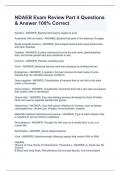NDAEB Exam Review Part 4 Questions
& Answer 100% Correct
Aerobes - ANSWER_Bacteria that require oxygen to grow
Anaerobes (AN-uh-roebz) - ANSWER_Bacteria that grow in the absence of oxygen
Bacilli (singular,bacillus) - ANSWER_Rod shaped bacteria that cause tuberculosis
and other diseases
Candida - ANSWER_A yeast commonly found in the oral cavity, gastrointestinal
tract, and female genital tract and sometimes in skin
Chancre - ANSWER_Painless ulcerating sore
Cocci - ANSWER_Spherical bacteria cells that reproduce by dividing into two
Endospores - ANSWER_A resistant, dormant structure formed inside of some
bacteria that can withstand adverse conditions
Gram negative - ANSWER_Classification of bacteria that do not hold a dye stain
under a microscope
Gram positive - ANSWER_Classification of bacteria that hold a dye stain and appear
dark purple under a microscpoe
Grams stain - ANSWER_Four step staining process developed by Hans Christian
Gram and used to separate bacteria into groups
Herpesvirus - ANSWER_Virus that causes infections in humans, such as herpes,
cytomegalovirus, chicken pox, shingles, mononucleosis, measles
Methicillin-resistant staphylococcus aureus - ANSWER_Type of staph infection that
is resistant to several common antibiotics
Percutaneous - ANSWER_Through the skin such as a needle stick, a cut, or a
human bite
Spirochetes - ANSWER_Spiral shaped bacteria
Virus - ANSWER_Ultramicroscopic infectious agents that contain DNA or RNA
Hepatitis
(Source of Virus, Route of Transmission, Prevention) - ANSWER_A- Fecal oral, No
Vaccine
B-Blood and body fluids, Percutaneous and mucosal tissues, Yes Immunization
,C-Blood and body fluids, Percutaneous and mucosal tissues, Preform bold donor
screening, modify risky behaviour
D-Blood and body fluids, Percutaneous and mucosal tissues, HBV vaccine
E-Fecal oral, Ensure safe drinking water
Symptoms of Hepatitis A,B,C - ANSWER_Fatigue, loss of appetite, Nausea,
abdominal discomfort, dark urine, clay coloured bowel movements, yellowing of the
skin (jaundice)
Herpes.
Type 1
Type 2
Herpes zoster virus (HZV) - ANSWER_Type 1- causes primarily oral lesions
Type 2- causes primarily genital lesions
HZV- causes shingles, and chicken pox
Syphilis - ANSWER_STD caused by Treponema palladium spirochetes.
1st stage-Presence of painless chancre (infectious on contact).
2nd stage-Comes an open sore (infectious). signs are split papule at the corners of
the mouth, Greyish-white moist mucous patches on the tongue, roof of mouth, tonsils
or inner surfaces of the lips.
3rd stage- latent syphilis is usually fatal and may occur after the disease has been
dominant for 20 years.
Acute infection - ANSWER_infection of short duration that is often severe
Chronic infection - ANSWER_A infection of long duration
Droplet infection - ANSWER_An infection occurs through musical surfaces of the
eyes, nose or mouth
Indirect contact - ANSWER_Touching or contact with a contaminated surface or
instrument
Latent Infection - ANSWER_Persistant infection with recurrent symptoms that come
and go
Chain of infection - ANSWER_1) Infectious agent
2) Reservoir
3) Portal of exit
4) Mode of transmission
5) Portal of entry
6) Susceptible host
Antiseptic - ANSWER_Used for antimicrobial (organism killing) agents that are
applied to living tissue
Disinfectant - ANSWER_Are chemicals that destroy or inactivate most species of
pathogenic (disease causing) microorganisms
,7 Steps in Reprocessing instruments - ANSWER_1) Transport
2) Cleaning
3) Packaging
4) Sterilization
5) Storage
6) Delivery
7) Quality
Critical instruments - ANSWER_Touch bone or penetrate soft tissue
Semi Critical instruments - ANSWER_Touch mucous membrane but will not touch
bone or penetrate soft tissue
Non Critical instruments - ANSWER_Contact only with intact skin
American Dental Assistants Association (ADAA) - ANSWER_The professional
organization of dental assistants in the United States.
American Dental Association (ADA) - ANSWER_Profesional organization for dentists
ADHA - ANSWER_Organization for Hygienists
Centres or Disease and Control Prevention (CDC) - ANSWER_Federal agency that
is non regulatory and that issues recommendation on heath and safety
Environmental Protection Agency (EPA) - ANSWER_Responsible for protecting and
restoring the environment and public health through environment laws
Food and Drug Admin (FDA) - ANSWER_Regulates food,drugs, medical devices.
NIOSH - ANSWER_Non regulatory and provides national and worldwide leadership
to prevent work related illness and injuries
OSHA - ANSWER_inspections may occur when employee or patient complain is
made, randomly in an office over 11 employees, upon request of the DDS
Carpel Tunnel Syndrome - ANSWER_Pain associated with continued flexion and
extension of the wrist
Cumulative Trauma disorders (CTD) - ANSWER_Painful condition that results from
ongoing stresses to muscles, tendons, nerves, and joints
Musculoskeletal disorders - ANSWER_Painful conditions that affect both muscles
and bones, such as neck or back pain and carpel tunnel syndrome
Thenar eminence (THEE-nar EH-meh-nents_ - ANSWER_Fleshy mound on the
palm at the base of the thumb
, HIPAA - ANSWER_The Health Insurance Portability and Accountability Act of 1996
describes the federal regulations that ensure privacy regarding a patients healthcare
information
Diagnostic information gathering info include - ANSWER_1- Physical examination
form (Posture, vital signs, communication skills)
2-Radiographic Exam (PA, BW's, PAN)
3- Clinical exam (extraoral exam, intraoral exam, periodontal exam)
Antecubital space - ANSWER_Small groove or fold in the inner arm
Arrhythmia - ANSWER_Abnormality and irregularity in the force of rhythm of the
heartbeat
Blood pressure - ANSWER_Pressure exerted on the walls of the blood vessels
Brachial artery - ANSWER_Located in the upper arm
Carotid artery - ANSWER_Located in the neck
Diastolic - ANSWER_The normal rhythm relaxation and dilation of the heart
chambers
Korotkoff sounds - ANSWER_Specific sounds heard when one is taking a blood
pressure.
Radial artery - ANSWER_Located in the wrist
4 vital signs are... - ANSWER_1)Temperature
2) Pulse
3)Respiration
4) Blood Pressure
Normal Temperature of a resting person - ANSWER_97.7 F-99 F (36.4 C- 37.3 C)
Normal range of pulse of resting adult
Normal range of pulse of resting child - ANSWER_60-100 bpm
70-120 bpm
Normal range of respiratory for resting adult
Normal range of respiratory for resting child - ANSWER_10-20 Breaths per minute
18-30 breaths per minute
Normal range of pulse for resting adult
Prehypertension
Hypertension stage 1
Hypertension stage 2 - ANSWER_120/80
120-139/80-89
140-159/90-99
Greater than 160/ greater than 100




